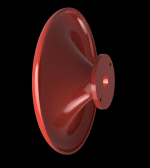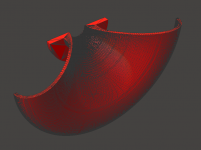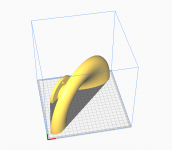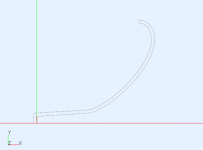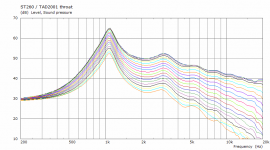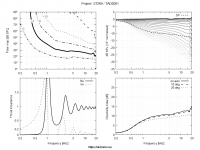Calculates minimum phase from the simulated amplitude response and compare that to the simulated phase response?
It seems to me that mode 0 has to be MP, but >0 will not. If this is true (likely. but not positive,) then this could be used to find the HOM contributions - compare the MP impulse reconstruction to the actual impulse.
To have some fun and to encourage people to actually try a free standing waveguide, I decided to release my first "serious" design of this type (was already measured here some time ago with several drivers).
It is called ST260 (ST = Small Teaser), cca ⌀260 mm x 83 mm.
Throat entry angle is 19° and should work well with majority of 1" drivers.
STEP and STL files of the ready-to-print waveguide available: https://at-horns.eu/release/ST260.zip
Have fun and give us a feedback! 🙂
It is called ST260 (ST = Small Teaser), cca ⌀260 mm x 83 mm.
Throat entry angle is 19° and should work well with majority of 1" drivers.
STEP and STL files of the ready-to-print waveguide available: https://at-horns.eu/release/ST260.zip
Have fun and give us a feedback! 🙂
Attachments
Just got the word from Jack Elliano that Dr. Bruce Edgar has passed away. A true giant in horn design, and a real gentleman. R.I. P. Dr. Bruce !!
Joe
Joe
To have some fun and to encourage people to actually try a free standing waveguide, I decided to release my first "serious" design of this type (was already measured here some time ago with several drivers).
It is called ST260 (ST = Small Teaser), cca ⌀260 mm x 83 mm.
Throat entry angle is 19° and should work well with majority of 1" drivers.
Have fun and give us a feedback! 🙂
WOW thanks for all the awesome work, ATH and ST260 gift

Perfect timing, just got my first creality printer I can try this with.
Would this Small Teaser work with TAD2001?
I believe it has a very narrow 3.6degree throat angle.
JMLC horns represent smooth termination of an exponential horn into free air. That's fine.
Actually, JMLC's method was based on entirely different assumptions.
This is what he said about Salmon type of horns:
"One more time I have to say: Webster’s equation is a differential equation and describe what happens inside an “infinitesimal volume = at the microscopic scale, not at the macroscopic scale. The plane wave hypothesis at that infinitesimal scale is valid but cannot be translated at the macroscopical scale = on the whole horn. Horns calculated with a (planar) cross sectional evolution following exponential law, hypex law or every kind of law belonging to the hyperbolic family are a mistake! At the macroscopical scale it is the area of equipressure and equiphase surfaces propagating inside the horn that should follow the expansion law solution of Webster’s equation. (Theoricaly within a perfect horn equipressures surfaces should be also equiphase surfaces)."
Just got the word from Jack Elliano that Dr. Bruce Edgar has passed away. A true giant in horn design, and a real gentleman. R.I. P. Dr. Bruce !!
Joe
Maybe consider starting a thread here
Was able to meet Dr. Bruce Edgar at CES and he was kind enough to let us demonstrated some gear in his room when we suggester it might help with an issue he was experiencing, a really regular down to earth man who was kind and open. RIP.
Last edited:
I've started a thread here - RIP Dr Bruce EdgarJust got the word from Jack Elliano that Dr. Bruce Edgar has passed away. A true giant in horn design, and a real gentleman. R.I. P. Dr. Bruce !!
Joe
If you wish to do the honour of posting a little more, I'll move your post to the top of the thread (where you can edit it as needed)
I only described the result based on what I see as a result - I'm a simple man. I'm not really sure that the motivation or the stories behind that are what counts.Actually, JMLC's method was based on entirely different assumptions.
You could try it, the polars are still good, but be carefull about EQ as it will probably tend to ring horrendously on several frequencies (and this could be corrected if done right). Matching the entry angle would not change much in this case, I've just tried that.Would this Small Teaser work with TAD2001?
I believe it has a very narrow 3.6degree throat angle.
Below is a simulation of ST260 with the TAD2001 throat added.
You would probably need something like a JMLC horn for this kind of driver 🙂 (I could do it with OS-SE but it would beam terribly.)
Attachments
Last edited:
BTW, in Ath such a throat extension can be added simply like this (that's what I did above):
Throat.Ext.Length = 65 ; [mm]
Throat.Ext.Angle = 3.6 ; [deg]
Throat.Ext.Length = 65 ; [mm]
Throat.Ext.Angle = 3.6 ; [deg]
You would probably need something like a JMLC horn for this kind of driver 🙂
JMLC owned several pairs of TD-2001, which should be indicative.
The TD-2001 also works with radial horns, for those who prefer a wider dispersion.
TD-2001 + Arai 480:
Joseph Crowe made a customized ES-600 Biradial for the TAD TD-2001.
Well it would work with the ST260 too. It would only need some additional EQ, that's not a priori a bad thing. It's not quite clean with the other horns either.
Last edited:
- Home
- Loudspeakers
- Multi-Way
- Acoustic Horn Design – The Easy Way (Ath4)

